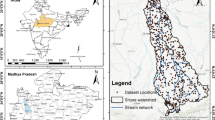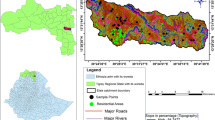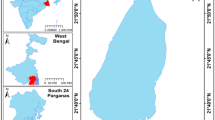Abstract
An increase in population expansion, urban sprawling environment, and climate change has resulted in increased food demand, water scarcity, environmental pollution, and mismanagement of water resources. Groundwater, i.e., one of the most precious and mined natural resources is used to address a variety of environmental demands. Among all, irrigation is one of the leading consumers of groundwater. Various natural heterogeneities and anthropogenic activities have impacted the groundwater quality. As a result, monitoring groundwater quality and determining its suitability are critical for the sustainable long-term management of groundwater resources. In this study, groundwater samples from 35 different sampling stations were collected and tested for various parameters associated with irrigation water quality. Hybrid MCDM (fuzzy-AHP) method was used to determine the groundwater suitability for irrigation purposes. The suitability map obtained using spatial overlay analysis was classified into low, moderate, and high irrigation water suitability zones. Along with suitability analysis, various regression-based machine learning models such as multiple linear regression (MLR), random forest (RF), and artificial neural network (ANN) were used and compared to predict irrigation water suitability. Results depicted that the ANN model with the highest R2 value of 0.990 and RMSE value near to zero (0) has outperformed all other models. The present methodology could be found useful to predict irrigation water suitability in the region where regular sampling and analysis are quite challenging.










Similar content being viewed by others
Data availability
The datasets used and/or analyzed during the current study are available from the corresponding author on reasonable request.
References
Abba SI, Hadi SJ, Abdullahi J (2017) River water modelling prediction using multi-linear regression, artificial neural network, and adaptive neuro-fuzzy inference system techniques. Procedia Comput Sci 120:75–82. https://doi.org/10.1016/j.procs.2017.11.212
Abdel-Fattah MK, Mokhtar A, Abdo AI (2021) Application of neural network and time series modeling to study the suitability of drain water quality for irrigation: a case study from Egypt. Environ Sci Pollut Res 28:898–914. https://doi.org/10.1007/s11356-020-10543-3
Ağca N (2014) Spatial variability of groundwater quality and its suitability for drinking and irrigation in the Amik Plain (South Turkey). Environ Earth Sci 72:4115–4130. https://doi.org/10.1007/s12665-014-3305-7
APHA (2005) Standard Methods for the Examination of Water and Wastewater, 21st ed.; APHA:Washington, DC, USA, 2005. Am Water Work Assoc Public Work Assoc Environ Fed 552. https://doi.org/10.2105/AJPH.51.6.940-a
Arias-Estévez M, López-Periago E, Martínez-Carballo E et al (2008) The mobility and degradation of pesticides in soils and the pollution of groundwater resources. Agric Ecosyst Environ 123:247–260. https://doi.org/10.1016/j.agee.2007.07.011
Batarseh M, Imreizeeq E, Tilev S et al (2021) Groundwater for sustainable development assessment of groundwater quality for irrigation in the arid regions using irrigation water quality index ( IWQI ) and GIS-Zoning maps : case study from Abu Dhabi Emirate. UAE Groundw Sustain Dev 14:100611. https://doi.org/10.1016/j.gsd.2021.100611
Behra UK, Mohanty BK, Lahiri S, Ray JN, Gupta GD, Prakash HSM, Kesari GK (2011) Geology and mineral resources of Manipur, Mizoram, Nagaland and Tripura. Geol Surv India Misc Pub (30):4
Belkhiri L, Narany TS (2015) Using multivariate statistical analysis, geostatistical techniques and structural equation modeling to identify spatial variability of groundwater quality. Water Resour Manag 29:2073–2089. https://doi.org/10.1007/s11269-015-0929-7
BIS (1986) IS 11624 (1986) Guidelines for the quality of irrigation water. New Delhi: Bureau of Indian Standards
Bozdağ A (2015) Combining AHP with GIS for assessment of irrigation water quality in Çumra irrigation district (Konya), Central Anatolia, Turkey. Environ Earth Sci 73:8217–8236. https://doi.org/10.1007/s12665-014-3972-4
Breiman L (1996) Bagging predictors. Mach Learn 24:123–140. https://doi.org/10.1007/BF00058655
Breiman L (2001a) Statistical modeling: the two cultures (with comments and a rejoinder by the author). Stat Sci 16:199–231
Breiman L (2001b) Random forests. Mach Learn 45:5–32. https://doi.org/10.1023/A:1010933404324
Burri NM, Weatherl R, Moeck C, Schirmer M (2019) A review of threats to groundwater quality in the anthropocene. Sci Total Environ 684:136–154. https://doi.org/10.1016/j.scitotenv.2019.05.236
Chakma A, Bhowmik T, Mallik S, Mishra U (2022) Application of GIS and geostatistical interpolation method for groundwater mapping. In: Advanced modelling and innovations in water resources engineering. Springer, Singapore. pp 419–428. https://doi.org/10.1007/978-981-16-4629-4_29
Chen W-B, Liu W-C (2015) Water quality modeling in reservoirs using multivariate linear regression and two neural network models. Adv Artif Neural Syst 2015:1–12. https://doi.org/10.1155/2015/521721
Chen Y, Song L, Liu Y, et al (2020) A review of the artificial neural network models for water quality prediction. Appl Sci 10.https://doi.org/10.3390/app10175776
Cho KH, Sthiannopkao S, Pachepsky YA et al (2011) Prediction of contamination potential of groundwater arsenic in Cambodia, Laos, and Thailand using artificial neural network. Water Res 45:5535–5544. https://doi.org/10.1016/j.watres.2011.08.010
Das B, Chandra S (2020) Assessment of groundwater vulnerability to over - exploitation using MCDA, AHP, fuzzy logic and novel ensemble models : a case study of Goghat - I and II blocks of West Bengal, India. Environ Earth Sci 79:1–16. https://doi.org/10.1007/s12665-020-8843-6
Delgado C, Pacheco J, Cabrera A et al (2010) Quality of groundwater for irrigation in tropical karst environment: the case of Yucatán, Mexico. Agric Water Manag 97:1423–1433. https://doi.org/10.1016/j.agwat.2010.04.006
Díaz-Alcaide S, Martínez-Santos P (2019) Review: Advances in groundwater potential mapping. Hydrogeol J 27:2307–2324. https://doi.org/10.1007/s10040-019-02001-3
El Bilali A, Taleb A (2020) Prediction of irrigation water quality parameters using machine learning models in a semi-arid environment. J Saudi Soc Agric Sci 19:439–451. https://doi.org/10.1016/j.jssas.2020.08.001
El Bilali A, Taleb A, Brouziyne Y (2020) Groundwater quality forecasting using machine learning algorithms for irrigation purposes. Agric Water Manag 106625.https://doi.org/10.1016/j.agwat.2020.106625
Emamgholizadeh S, Kashi H, Marofpoor I, Zalaghi E (2014) Prediction of water quality parameters of Karoon River (Iran) by artificial intelligence-based models. Int J Environ Sci Technol 11:645–656. https://doi.org/10.1007/s13762-013-0378-x
Emamgholizadeh S, Shahsavani S, Eslami MA (2017) Comparison of artificial neural networks, geographically weighted regression and Cokriging methods for predicting the spatial distribution of soil macronutrients (N, P, and K). Chinese Geogr Sci 27:747–759. https://doi.org/10.1007/s11769-017-0906-6
Gajbhiye S, Ehsan M, Vijay A, Meshram C (2019) Comparison of AHP and fuzzy AHP models for prioritization of watersheds. Soft Comput 23:13615–13625. https://doi.org/10.1007/s00500-019-03900-z
Jalali M (2008) Effect of sodium and magnesium on kinetics of potassium release in some calcareous soils of western Iran. Geoderma 145:207–215. https://doi.org/10.1016/j.geoderma.2008.03.005
Kadam AK, Wagh VM, Muley AA et al (2019) Prediction of water quality index using artificial neural network and multiple linear regression modelling approach in Shivganga River basin, India. Model Earth Syst Environ 5:951–962. https://doi.org/10.1007/s40808-019-00581-3
Kashi H, Emamgholizadeh S, Ghorbani H (2014) Estimation of soil infiltration and cation exchange capacity based on multiple regression, ANN (RBF, MLP), and ANFIS models. Commun Soil Sci Plant Anal 45:1195–1213. https://doi.org/10.1080/00103624.2013.874029
Kouadri S, Pande CB, Panneerselvam B et al (2021) Prediction of irrigation groundwater quality parameters using ANN, LSTM, and MLR models. Environ Sci Pollut Res. https://doi.org/10.1007/s11356-021-17084-3
Kulkarni AD, Lowe B (2016) Random forest algorithm for land cover classification. International Journal on Recent and Innovation Trends in Computing and Communication (IJRITCC) pp. 58–63
Kumar M, Singh P, Singh P, Region C (2021) Fuzzy AHP based GIS and remote sensing techniques for the groundwater potential zonation for Bundelkhand Craton Region , India Fuzzy AHP based GIS and remote sensing techniques for. Geocarto Int 0:1–24. https://doi.org/10.1080/10106049.2021.1946170
Latha M (2019) Prediction of irrigation water quality index using artificial neural network. Int J Appl Eng Res 14:952–956
Li J, Heap AD (2011) A review of comparative studies of spatial interpolation methods in environmental sciences: performance and impact factors. Ecol Inform 6:228–241. https://doi.org/10.1016/j.ecoinf.2010.12.003
Liaw A, Wiener M et al (2002) Classification and regression by randomForest. R News 2:18–22
Mallik S, Bhowmik T, Mishra U, Paul N (2021a) Local scale groundwater vulnerability assessment with an improved DRASTIC model. Nat Resour Res. https://doi.org/10.1007/s11053-021-09839-z
Mallik S, Mishra U, Paul N (2021b) Groundwater suitability analysis for drinking using GIS based fuzzy logic. Ecol Indic 121:107179. https://doi.org/10.1016/j.ecolind.2020.107179
Meireles ACM, de Andrade EM, Chaves LCG et al (2010) A new proposal of the classification of irrigation water. Rev Ciência Agronômica 41:349–357. https://doi.org/10.1590/s1806-66902010000300005
Mohebbi Tafreshi A, Mohebbi Tafreshi G, Bijeh Keshavarzi MH (2018) Qualitative zoning of groundwater to assessment suitable drinking water using fuzzy logic spatial modelling via GIS. Water Environ J 32:607–620
Mosadeghi R, Warnken J, Tomlinson R, Mirfenderesk H (2015) Comparison of Fuzzy-AHP and AHP in a spatial multi-criteria decision making model for urban land-use planning. Comput Environ Urban Syst 49:54–65. https://doi.org/10.1016/j.compenvurbsys.2014.10.001
Park Y, Ligaray M, Kim YM et al (2016) Development of enhanced groundwater arsenic prediction model using machine learning approaches in Southeast Asian countries. Desalin Water Treat 57:12227–12236. https://doi.org/10.1080/19443994.2015.1049411
Parmar KS, Bhardwaj R (2015) River water prediction modeling using neural networks, fuzzy and wavelet coupled model. Water Resour Manag 29:17–33. https://doi.org/10.1007/s11269-014-0824-7
Rahmati O, Pourghasemi HR, Melesse AM (2016) Application of GIS-based data driven random forest and maximum entropy models for groundwater potential mapping: a case study at Mehran Region. Iran Catena 137:360–372. https://doi.org/10.1016/j.catena.2015.10.010
Raines GL, Sawatzky DL, Bonham-Carter GF (2010) New fuzzy logic tools in ArcGIS 10. ArcUser Spring p. 8–13. https://www.esri.com/news/arcuser/0410/fuzzylogic.html
Saaty RW (1987) The analytic hierarchy process-what it is and how it is used. Math Model 9:161–176. https://doi.org/10.1016/0270-0255(87)90473-8
Saaty TL (2004) Fundamentals of the analytic network process — multiple networks with benefits, costs, opportunities and risks. J Syst Sci Syst Eng 13:348–379. https://doi.org/10.1007/s11518-006-0171-1
Saha S, Mallik S, Mishra U (2020) Groundwater depth forecasting using machine learning and artificial intelligence techniques : a survey of the literature In: Recent developments in sustainable infrastructure (ICRDSI-2020)—GEO-TRA-ENV-WRM. Lecture Notes Civ Eng 207:153–167
Sakizadeh M (2016) Artificial intelligence for the prediction of water quality index in groundwater systems. Model Earth Syst Environ 2:1–9. https://doi.org/10.1007/s40808-015-0063-9
Singh A (2014) Conjunctive use of water resources for sustainable irrigated agriculture. J Hydrol 519:1688–1697. https://doi.org/10.1016/j.jhydrol.2014.09.049
Singh DK, Singh AK (2002) Groundwater situation in India: problems and perspective. Int J Water Resour Dev 18:563–580. https://doi.org/10.1080/0790062022000017400
Singh S, Ghosh NC, Gurjar S (2018) Index-based assessment of suitability of water quality for irrigation purpose under Indian conditions. Env Monit Assess 190:29. https://doi.org/10.1007/s10661-017-6407-3
Singha S, Pasupuleti S, Singha SS et al (2021) Prediction of groundwater quality using efficient machine learning technique. Chemosphere 276:130265. https://doi.org/10.1016/j.chemosphere.2021.130265
Sutradhar S, Mondal P (2021) Groundwater suitability assessment based on water quality index and hydrochemical characterization of Suri Sadar Sub-division. West Bengal Ecol Inform 64:101335. https://doi.org/10.1016/j.ecoinf.2021.101335
Talukdar S, Pal S (2019) Wetland Habitat Vulnerability of Lower Punarbhaba river basin of the uplifted Barind Region of Indo- Bangladesh. Geocarto Int pp. 1–30. https://doi.org/10.1080/10106049.2018.1533594
Tarun DCJ, Pandey KHK, Kumar S et al (2019) Assessment of groundwater vulnerability to pollution by modified DRASTIC model and analytic hierarchy process. Environ Earth Sci 78:1–20. https://doi.org/10.1007/s12665-019-8608-2
Taşan S, Demir Y (2020) Comparative analysis of MLR, ANN, and ANFIS models for prediction of field capacity and permanent wilting point for Bafra plain soils. Commun Soil Sci Plant Anal 51:604–621. https://doi.org/10.1080/00103624.2020.1729374
Tashayo B, Honarbakhsh A, Azma A, Akbari M (2020) Combined fuzzy AHP – GIS for agricultural land suitability modeling for a watershed in southern Iran. Environ Manage. https://doi.org/10.1007/s00267-020-01310-8
Towfiqul Islam ARM, Shen S, Bodrud-Doza M, Safiur Rahman M (2017) Assessing irrigation water quality in Faridpur district of Bangladesh using several indices and statistical approaches. Arab J Geosci 10. https://doi.org/10.1007/s12517-017-3199-2
Vasanthavigar M, Srinivasamoorthy K, Vijayaragavan K et al (2010) Application of water quality index for groundwater quality assessment: Thirumanimuttar sub-basin, Tamilnadu, India. Environ Monit Assess 171:595–609. https://doi.org/10.1007/s10661-009-1302-1
Von Der Heyden CJ, New MG (2004) Groundwater pollution on the Zambian Copperbelt: deciphering the source and the risk. Sci Total Environ 327:17–30. https://doi.org/10.1016/j.scitotenv.2003.08.028
Wagh VM, Panaskar DB, Muley AA et al (2016) Prediction of groundwater suitability for irrigation using artificial neural network model: a case study of Nanded tehsil, Maharashtra, India. Model Earth Syst Environ 2:1–10. https://doi.org/10.1007/s40808-016-0250-3
Wanda EMM, Gulula LC, Phiri A (2013) Hydrochemical assessment of groundwater used for irrigation in Rumphi and Karonga districts, Northern Malawi. Phys Chem Earth 66:51–59. https://doi.org/10.1016/j.pce.2013.09.001
Yilma M, Kiflie Z, Windsperger A, Gessese N (2018) Application of artificial neural network in water quality index prediction: a case study in Little Akaki River, Addis Ababa, Ethiopia. Model Earth Syst Environ 4:175–187. https://doi.org/10.1007/s40808-018-0437-x
Yıldız S, Karakuş CB (2020) Estimation of irrigation water quality index with development of an optimum model: a case study. Environ Dev Sustain 22.5:4771–4786
Zarei AR, Mahmoudi MR, Shabani A (2021) Investigating of the climatic parameters effectiveness rate on barley water requirement using the random forest algorithm, Bayesian multiple linear regression and cross-correlation function. Paddy Water Environ 19:137–148
Acknowledgements
The authors are grateful to the principal College of Agriculture, Tripura and Department of Soil Science lab for providing us resources to carry out the lab testing and analysis.
Funding
Not applicable.
Author information
Authors and Affiliations
Contributions
Santanu Mallik: methodology development, writing—original draft, writing—review and editing.
Abhigyan Chakraborty: sample collection and analyzing.
Niladri Pal: data accumulation, conceptualization, editing.
Umesh Mishra: supervision, resources, conceptualization.
Corresponding author
Ethics declarations
Ethics approval and consent to participate
Not applicable.
Consent for publication
Not applicable.
Competing interests
The authors declare no competing interests.
Additional information
Responsible Editor: Marcus Schulz
Publisher's note
Springer Nature remains neutral with regard to jurisdictional claims in published maps and institutional affiliations.
Supplementary Information
Below is the link to the electronic supplementary material.
Rights and permissions
About this article
Cite this article
Mallik, S., Chakraborty, A., Mishra, U. et al. Prediction of irrigation water suitability using geospatial computing approach: a case study of Agartala city, India. Environ Sci Pollut Res 30, 116522–116537 (2023). https://doi.org/10.1007/s11356-022-21232-8
Received:
Accepted:
Published:
Issue Date:
DOI: https://doi.org/10.1007/s11356-022-21232-8




